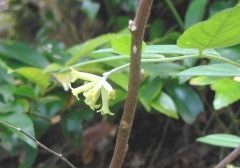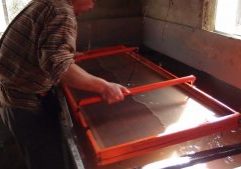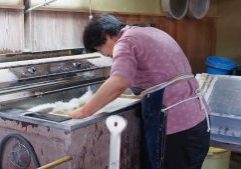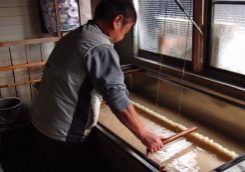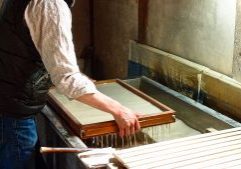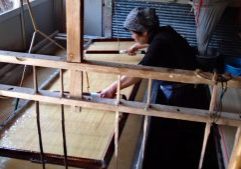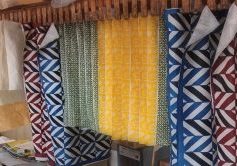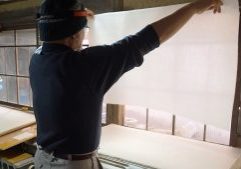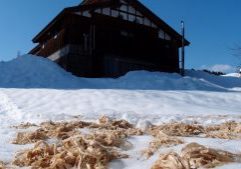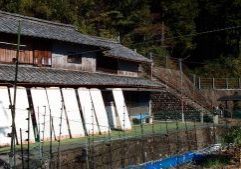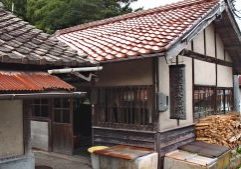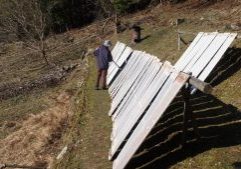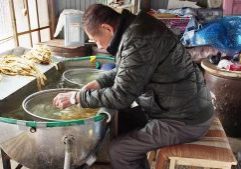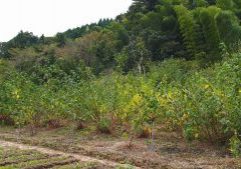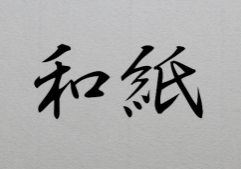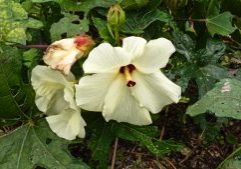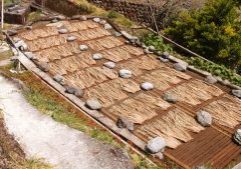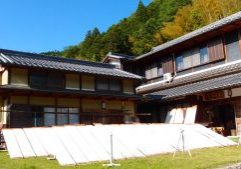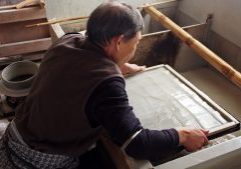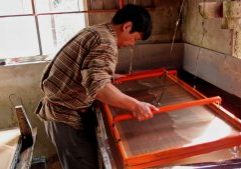Are you lookin' for Japanese Handmade paper? You reached the right site, here!
Pick Up
Material: Gampi 雁皮/ガンピ
Gampi is one of the original materials in Japan. The Gampi paper has been called “King of paper”. The oldest, dated on AD702, remaining paper in Japan was made from Gampi.The color is slightly brownish, if it’s not chemically bleached.The surface is slick and shiny, plus very strong. The fibre is much shorter than Kozo’s, roughly up to 3mm. This short fibre can be interlocked tightly, for making strong paper. Also, it has a strong resistance to damage of bugs.The plant can’t be cultivated on the farm. Some districts have been trying to grow it, but not succeeded until now. It’s available only in the wild, and it’s becoming rare […]
Read MoreProcess: Nagashi-zuki (Kami-suki #1)
Nagashi-Zuki (流し漉き) is the most commonly-used method of Washi making. It was developed roughly 1,000 years ago. In this method, an artisan shakes the mould (sugeta) intensely. The manner of shaking horizontally and vertically depends on the kind of paper being made. This method is effective for making strong paper, as the fibers bind together tightly. An artisan can control the thickness easily with this method. The fibre solution in the vat is the water mixed with fibre and dispersant (Neri), which suspends and spreads the fibres evenly on the screen. Related Topics
Read MoreProcess: Subuse (Kami-suki #4)
Subuse is a special rare method of Washi making, inherited by only two workshops in Yoshino. The artisan scoops the fibre solution with the mould and shakes it, then immediately pastes it on a wooden board directly, skipping the paper layering phase. Because many boards are required, and carrying them outside takes much time, this method is at least a two-person job. Usually, the wife is the scooper and the husband is the carrier. So, they say, a Subuse family never has domestic fights. Good partnership is the essence for good paper. Because the paper is not pressed, it becomes very fluffy. The wet raw paper is very delicate and […]
Read MoreProcess: Tome-zuki (Kami-suki #3)
Tome-Zuki is the hybrid method of Tame-zuki and Nagashi-zuki, so it is called also Tame-Nagashi-Zuki. ”Tome” means “Keeping” or “Stopping”. The artisan scoops the fibre solution from the vat, then shakes the mould and waits for a while until the material drains. The timing is not strictly defined, and only recognized by the artisans individually. Uda-gami of Yoshino is made using this method. Although this is not a widely-used method, some of the artisans use this method occasionally to suit a particular requirement. Related Topics
Read MoreProcess: Tame-zuki (Kami-suki #2)
Tame-zuki(溜め漉き) is an old-style, slightly rare method of Washi making. It is similar to the papermaking methods used outside of Japan. “Tame” means “Collecting”, and in this case refers to the material, fibre solution. The artisan doesn’t intensely shake the mould (Sugeta). They just scoop the fibre solution from the vat and calmly wait for water to drain. This method is effective for a special paper that contains clay, because the method without well-shaking like this, it easily makes uneven and pin-hole. the clay works as the filler. Commonly, the scooped paper is couched with a gauze cloth one sheet at a time. The screen is set into a mould, which […]
Read MoreTS- Tosa Washi
Tosa is the old name of Kochi prefecture. The Tosa paper was listed on the record book “Engi-shiki (延喜式)” at the very early stage, has more than 1300 years in the history. Since the Edo period (1603-1868) to present, Tosa has been one of the three biggest production sites together with Mino and Echizen. There is rich water and sunshine. So, here is quite prominent as not only paper production but also Kozo farming. Ino-cho, along the clear stream Niyodo river, is the centre of production, and also some artisans are making paper in other areas in Kochi prefecture. Papermaking is the local pride for Tosa people. There are many […]
Read MoreYT-01 Yatsuo Washi / Keijusha
There were almost 500 paper-makers alongside Ida River in Yatsuo town 100 years ago. This province “Ecchu” was famous as medicine production. The Ecchu-washi was grown with medicine business, like wrapping paper and bags for the powder and tablets. After WW2, the living national treasure of cloth-dyeing artisan, Mr Serizawa Keisuke (芹澤銈介), started dyeing on papers with Keijusha, instead of clothes, because of its lack. Today, they are making more than 250 beautiful patterned papers. This is one of the representatives of the Japanese folk-art. PAPERS DESTRICT INFO WORKSHOP INFO ARTISANS PAPERS DESTRICT INFO Code YT Name Yatsuo Washi (八尾和紙) Another Name Ecchu Washi (越中和紙) Center Place Toyama Pref., Toyama-City, […]
Read MoreTK-01 Tokudi Washi / Chijimatsu Washi Workshop
Around 1200, a Buddhist monk “Chougen” taught the Washi making method to the people. Through the 17-19C, the Lord protect and support them as the three major productions of Choshu-han. Although they are a small Washi making district at present, they were the biggest production place 100 years ago in Japan, more than 4,000 houses were engaged in Washi production. Before the modern tissue paper appeared, their “Shiraho-gami (白保紙)” was the best selling paper in Japan, especially among ladies. The history was almost disappearing recently. In 2014, Mr Chijimatsu Tomoyuki returned to his home to maintain the history fo his family. He learnt Washi making from his father who was […]
Read MoreKD-01 Echigo-Kadoide Washi / Koshi-no-Kigami Kobo
Although there are many Washi making districts, this is the definitely heaviest snow place. Sometimes it snows a couple of meters in one night. Because there is few sun-shine through winter, therefore they keep the wet paper stacking under the snow until April, quite unique method “Kangure”. They start drying the paper under the spring sun. The paper is surely like the original old Washi. Mr Kobayashi Yasuo has a credo, “How we can revive the wildlife in the paper for the 30th century”. He is definitely one of the representative of Washi artisans. PAPERS DESTRICT INFO WORKSHOP INFO ARTISANS PAPERS DESTRICT INFO Code KD Name Echigo-Kadoide Washi (越後門出和紙) Center […]
Read MoreMN-02 Ishihara Hidekazu
Although the Mino washi was made widely in Mino county, nowadays most of the workshops are sitting in Warabi area. This is the last workshop in Ueno area, where is little upstream of Itadori-river from Warabi. He makes various papers with his rich experience, especially focusing very thin “Usu-Mino paper (薄美濃紙)”. The thin paper is required not only high-skilled scooping work (recently done by his daughter) also pasting on wooden board skill is required, done by his wife, who is another master artisan. PAPERS WORKSHOP INFO ARTISANS PAPERS WORKSHOP INFO Code (District) MN-02 (Mino) Company Representative/Artisan Ishihara Hidekazu (石原英和) Established / Generation / 5th Location Gifu Pref., Mino-City, Kamino […]
Read MoreIM-01 Izumo-Mingei Shi Kobo
Mr Abe Eishirou(安部榮四郎) is one of the legends of modern Washi history. He led “Japanese folk-art movement(日本民藝運動)” together with Mr Bernard Leach and Mr Yanagi Souestu(柳宗悦), also investigated and researched the historical papers, including Shōsō-in treasures. He was certified as the first living national treasure of Washi in 1968 together with Mr Iwano Ichibei (8th) of Echizen. Many artisans were learnt and influenced by him. His grandsons keep running the workshop. They make various papers skillfully using Kozo/Mitsumata/Gampi, for instance, “Izumo Cloud paper” and “Gampi paper” which Mr Bernard Leach was impressed at. Their papers remain old atmosphere very well. PAPERS DISTRICT INFO WORKSHOP INFO ARTISANS PAPERS DISTRICT INFO Code […]
Read MoreProcess: Ita-boshi (Wooden Board Drying)
In the past, artisans put Washi on wooden board for drying. This method was very much depending on weathers, and heavy tough work.Roughly since a hundred years ago, drying on the warmed metal panel has permeated in Japan, then it became quite popular nowadays.Though using the metal panel is convenient, drying on wooden board has meaningful effectiveness. That is less damage to the fibre. Drying on wooden board is harmonizing with the same speed of shrinkage with papers and excess water is absorbed. As a result, the fibre doesn’t break off, become strong and soft paper.There are three styles of drying. First is “Sun Drying”, under the sunshine. This is […]
Read MoreProcess: Chiritori (Speck Removing)
Through the process of Washi making, artisans take most of the time, almost more than half, for speck removing. It is called “Chiri(塵=Speck/Dirt)-Tori(取り=Removing)”.Every artisan says “This is the most important process”. Not only to clean the material but also to understand the condition of the material. Even it is very patient work, they never cheat this work.Most of the cases, this work is done in the cold water. It is called “Mizu(水=Water)-Yori(選り=Picking/Choosing)”. In cold wintertime, it is the hardest work.Doing it on the board is another style, it is called “Oka(陸=Land)-Yori”. Although it is more time-consuming, is effective to prevent fibre draining away.In Yoshino only, they do this process using […]
Read MoreMaterial: Kozo 楮/コウゾ
Kozo is a kind of mulberry species, botanical point of view it is hybrid of “Broussonetia kazinoki” and “Broussonetia papyrifera”. It is the most popular material, roughly more than 90% of Washi since 1000 years ago. Generally, there are six species as below, classified in two groups. Kozo’s fibre is shorter than Kaji’s. => Kozo : Aka(Red)-so, Ao(Green)-so => Kaji : Taori, Kuro(Black)-kaji, Taka(High)-kaji, Ma-kajiEven so, it is not strictly separately using. The place of the farm is more importantly recognized for its quality and characteristic. In Japan, north latitude 40 degrees is the northern limit, in Iwate and Akita prefecture. Some of the famous farm-land is as below. => […]
Read MoreThe Word “Washi”
The word “Washi(和紙)” may not be recognized correctly. In the Japanese language, “Wa(和)” means “Japanese”, for example, “Wa-gyu(和牛)=Japanese beef”, “Wa-shoku(和食)=Japanese food”… This came from Japanese ancient country name “Yamato(大和)”. On the other hand, the imported (mainly from Europe and America) product is called “Yo(洋)-xxx” since around late 19C, like “Yo-shoku(洋食)=Western Food”, “Yo-fuku(洋服)=Western clothes”… This means the word “Washi” has not a long history, papers were just called “Kami(紙)”. After Western paper (“Yo-shi”=洋紙) came to the Japan market, the word “Washi” was created to distinguish to Western paper. The single letter ”紙” is pronounced “Kami” as alone, if attached with a proper noun, it may change “-Shi” or “-Gami” as below. […]
Read MoreMaterial: Neri (Dispersant) ネリ
“Neri” is the function name, what is used for well-melt of fibre when for scooping. Sometimes it’s easily misunderstood, the Neri is not adhesive, it works as a dispersant. Neri is highly viscous, but no glueing. The artisan mixes fibre and Neri in the vat. For the moment of scooping, Neri keeps an average density of fibre. The scooped wet paper is laid over and over, but not bonded. After scooping, the overlapped hundreds of paper is pressed for dewatering. At this time, the ingredient of Neri is mostly discharged. The root of Tororoaoi(トロロアオイ=Sunset Hibiscus) is the most popular Neri. But it doesn’t work well at high temperature, roughly said […]
Read MoreTS-01 Osaki Seishisho
In a small village on the cliff edge in upstream of Niyodo-River, the proud Osaki family has been preserving the tradition of Tosa Washi. They are also farming Kozo by themselves to serve high quality and responsible paper. Everything is remaining the same as 100 years ago, like Kozo farm, Steaming Barrel, Field Rinsing Pool, Sun Drying and so on. It is very rare to make large size O-ban (大判=183×63) by one person, and a high skill is required. Their paper is definitely historic original, indispensable for various Japanese culture. PAPERS WORKSHOP INFO ARTISANS PAPERS WORKSHOP INFO Code (District) TS-01 (Tosa) Company Osaki Seishisho (尾崎製紙所) Representative/Artisan Osaki Kojiro (尾崎孝次郎) Established […]
Read MoreYO-01 Fukunishi Washi Hompo
They stubbornly keep the traditional way of making Uda-Gami (宇陀紙), which is used for the National Treasures. The workshop stands on the upland, overlooking Yoshino river. It looks like the typical “Traditional Paper-making House”. Mr Fukunishi Masayuki is the holder of the Selected Preservation Techniques, which is certified by the National Government, same as his father. He is definitely the indispensable master artisan for Japanese culture preservation. PAPERS INFORMATION ARTISANS PAPERS INFORMATION Code (District) YO-01 (Yoshino) Company Fukunishi Washi Hompo (福西和紙本舗) Representative/Artisan Fukunishi Masayuki (福西正行) Established / Generation 19C / 6th Location Nara Pref., Yoshino-Gun, Yoshino-Cho, Kubogaito HomePage http://fukunishiwashihonpo.com/ No.of Workers (Sukite) 3 (1) Main Product Uda-gami (宇陀紙) / Cedar […]
Read MoreNJ-01 Baba Seishisho
Mr Baba Kazuhiko is the last artisan, who makes Gold-Leaf beating paper. Recently, most of the Gold-Leaf makers use glassine paper, very few makers still inherit their historic process of using the traditional paper. For such old-fashioned makers, he keeps making the paper. Even its purpose is very special narrow, but it can be utilized for many others. In history, the Najio Gampi paper was used for various Japanese culture, especially paintings. It is very thin, but very tough, and also anti-worm, because it contains clay. PAPERS INFORMATION ARTISANS PAPERS INFORMATION Code (District) NJ-01 (Najio) Company Baba Seishisho (馬場製紙所) Representative/Artisan Baba Kazuhiko (馬場和比古) Established / Generation Late 19C / 4th […]
Read MoreYK-01 Yokono Washi / Ueda Tesuki Washi Kojo
Mimasaka (美作), current a part of Okayama prefecture, has been known as a paper-making district since the 8th century. The name was described on the Shōsō-in(正倉院) document. At present, only the Ueda family in the Kami-Yokono village inherits the tradition. They use only Mitsumata, cultivated locally. The paper is used for the lining of Gold-Leaf, thin and strong, light yellow-brown coloured. That is one of the Washi which represents the Japanese culture. PAPERS DISTRICT INFO WORKSHOP INFO ARTISANS PAPERS DISTRICT INFO Code YK Name Yokono Washi (横野和紙) Another Name Mimasaka Shi (美作紙) Center Place Okayama Pref., Tsuyama-City, Kamitokono No. of Workshop +(Public Facility) 1 + ( 0 ) Core Products […]
Read More

